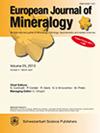山东金刚石中橄榄石包裹体的原位单晶x射线衍射:对金刚石形成深度的启示
IF 1.7
3区 地球科学
Q2 MINERALOGY
引用次数: 0
摘要
摘要我们研究了一组来自中国山东省蒙阴县昌马金伯利岩带金伯利岩管的天然钻石,目的是限制压力和温度的形成。在这里,我们报告了通过单晶x射线衍射对岩石圈钻石中仍被包裹的橄榄石包裹体的非破坏性调查。我们能够利用电离散射曲线将其晶体结构的各向异性细化到R1= 1.42%;这样就可以估计出橄榄石asMg1.82Fe0.18SiO4的成分。在室温和常压下,该成分对应于计算的单位胞体积= V= 292.70 Å3。我们通过将内含物从金刚石基体中释放出来,验证了上述计算的成分和单胞体积,从而得到了采用无损方法计算的一致的成分:Mg1.84Fe0.16SiO4和V= 292.80±0.07 Å3。考虑到仍在金刚石基体上的橄榄石的单位胞体积为V= 289.7±0.2 Å3,我们计算了在环境条件下,相对于释放晶体的残余压力Pinc= 1.4±0.1 GPa,相对于通过结构细化间接获得的“成分”计算的体积Pinc= 1.3±0.2 GPa。Pincoverlap的两个值在实验不确定度范围内。我们利用傅里叶变换红外(FTIR)对钻石母体进行分析,以计算其地幔停留温度Tres,结果得出1189°C(假设钻石年龄为3ga)和1218°C(假设钻石年龄为1ga),平均Tres为1204±15°C。利用最新的橄榄石和金刚石的压力-体积-温度状态方程,计算残余压力Pinc= 1.4±0.1 GPa,金刚石寄主的平均停留温度Tres= 1204°C,我们得到的包裹压力Ptrap= 6.3±0.4 GPa。在实验不确定度范围内,采用无损方法和相对pin = 1.3 GPa,得到了完全重叠的Ptrap= 6.2 GPa。这种夹带压力对应于大约190±12公里的深度。这些结果表明,对于仍然被困在钻石宿主内的包裹体测量的高质量晶体结构数据,即使采用非破坏性方法也可以用于计算钻石-橄榄石对的形成深度。就地质意义而言,这项工作的结果表明,昌玛钻石形成于35至40 mW m - 2的导电地热下,深度约为190公里。该值位于最近报道的全球岩石圈钻石平均形成深度的上限(175±15 km)内,与金伯利岩捕虏体中获得的p - t数据一致。本文章由计算机程序翻译,如有差异,请以英文原文为准。
In situ single-crystal X-ray diffraction of olivine inclusion in diamond from Shandong, China: implications for the depth of diamond formation
Abstract. We have investigated a suite of natural diamonds from the
kimberlite pipe of the Changma Kimberlite Belt, Mengyin County, Shandong
Province, China, with the aim of constraining pressures and temperatures of
formation. Here we report the non-destructive investigation of an olivine
inclusion still entrapped within a lithospheric diamond by single-crystal
X-ray diffraction. We were able to refine anisotropically its crystal
structure to R1= 1.42 % using ionized scattering curves; this
allows estimation of the composition of the olivine as
Mg1.82Fe0.18SiO4. This composition corresponds to a
calculated unit-cell volume equal to V= 292.70 Å3 at room
temperature and pressure. We have validated the above-calculated composition
and unit-cell volume by releasing the inclusion from the diamond host,
resulting in a consistent composition calculated using non-destructive
methods of Mg1.84Fe0.16SiO4 and V= 292.80 ± 0.07 Å3. Considering that the unit-cell volume of the olivine still
inside its diamond host is V= 289.7 ± 0.2 Å3, we calculated
a residual pressure Pinc= 1.4 ± 0.1 GPa with respect to the
released crystal and Pinc= 1.3 ± 0.2 GPa with respect to the
volume calculated from the “composition” indirectly retrieved by the
structure refinement under ambient conditions. The two values of Pinc
overlap within experimental uncertainty. We performed Fourier transform infrared (FTIR) analysis on the
diamond host in order to calculate its mantle residence temperature,
Tres, which resulted in a value of 1189 ∘C (for an assumed
diamond age of 3 Ga) and 1218 ∘C (for an age of 1 Ga), with an
average Tres equal to 1204 ± 15 ∘C. Using the most up-to-date pressure–volume–temperature equations of state for
olivine and diamond, the residual pressure Pinc= 1.4 ± 0.1 GPa
and average residence temperature of the diamond host Tres= 1204 ∘C, we retrieved a pressure of entrapment Ptrap= 6.3 ± 0.4 GPa. Using the non-destructive approach and relative Pinc = 1.3 GPa, we obtained a perfectly overlapping Ptrap= 6.2 GPa,
within experimental uncertainty. This entrapment pressure corresponds to
depths of about 190 ± 12 km. These results demonstrate that for
high-quality crystal structure data measured on inclusions still trapped
within diamond hosts, even a non-destructive approach can be used to
calculate the depth of formation of diamond–olivine pairs. In terms of
geological implications, the results from this work show that Changma
diamonds formed under a conductive geotherm lying between 35 and 40 mW m−2, at a depth of about 190 km. This value lies within the recently
reported upper limit of the average depth of formation of worldwide
lithospheric diamonds, which is 175 ± 15 km and is in agreement with
P–T data obtained in the literature from kimberlite xenoliths.
求助全文
通过发布文献求助,成功后即可免费获取论文全文。
去求助
来源期刊
CiteScore
2.80
自引率
9.50%
发文量
40
审稿时长
6-12 weeks
期刊介绍:
EJM was founded to reach a large audience on an international scale and also for achieving closer cooperation of European countries in the publication of scientific results. The founding societies have set themselves the task of publishing a journal of the highest standard open to all scientists performing mineralogical research in the widest sense of the term, all over the world. Contributions will therefore be published primarily in English.
EJM publishes original papers, review articles and letters dealing with the mineralogical sciences s.l., primarily mineralogy, petrology, geochemistry, crystallography and ore deposits, but also biomineralogy, environmental, applied and technical mineralogy. Nevertheless, papers in any related field, including cultural heritage, will be considered.

 求助内容:
求助内容: 应助结果提醒方式:
应助结果提醒方式:


